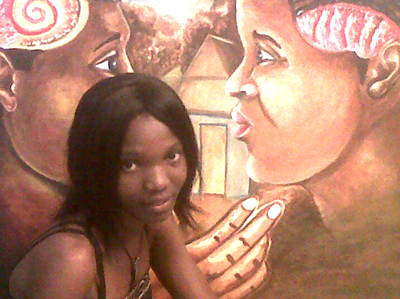
Roseanne swept her hand across hundreds of paintings and drawings waiting to be packed up for an upcoming art show. “And people come and say Haiti is the poorest country in the Western Hemisphere. I hate to hear that. There’s so much richness in this country.”
Roseanne, who is director of APROSIFA as well as a nurse and community organizer, held up one painting. It featured two hands nurturing a brilliantly colored women’s head; the hands seemed to be helping the woman open her mouth. “They’re envisioning all this despite the earthquake,” Roseanne said.
“These kids hear about violence every day,” Roseanne said. “We have to concentrate on what another country could be. That’s what interests me. If we had cultural centers in each shantytown, imagine what we could do. Culture and citizenship… if youth came and talked about this every day, found different ways to express their views on the matters, we could have a different country.”
“Other countries want to control us, giving us a little money for elections, a little money for development, while keeping the country as it is. But if we really had the chance to do for ourselves, if we had the means, you’d see what we could do.”
APROSIFA’s youth art program began in 2009 in a couple of cement-block rooms in the back of the clinic. A few professional artists donated their time to teach. Today, 68 youth from ages 8 to early 20s are painting and sculpting. A few of the youth who began learning two years ago are now teaching the others.
The artwork represents the daily stuff of Haitian life, like forms of labor, scenes inside village huts, vodou imagery, and landscapes. The work also feature historical heroes, maps of Haiti, and Escher-like clocks ticking away the country’s past.
When the young painters have canvas and paints, the images are bold, the colors brilliant. Often they have only sheets of typing paper and a pencil or a Bic pen. APROSIFA raises money to subsidize the supplies. “We give them string to fish with,” Roseanne said.
In late January, APROSIFA sponsored the Haitian Renaissance show at a hotel in downtown Port-au-Prince. On opening night, hundreds of people – journalists, artists, advocates for women, dignitaries, and especially youth from Carrefour-Feuilles – squeezed into several rooms whose walls were covered with art. The theme of the art was the Convention on the Elimination of All Forms of Discrimination against Women (CEDAW), which was adopted by the U.N. General Assembly in 1979 and took effect in 1981. Haiti ratified the convention in 1981 (unlike the U.S., which never has), though it has never been applied. Roseanne had given copies of the document to the young artists and had asked them to express their opinions creatively.
One youth whose work was featured is 22-year-old Islande Henry. She spoke in front of one of her paintings, of two women talking in front of their home, inspired by Article 16 of CEDAW which protects women and children’s rights in family relations. Islande said, “To me, CEDAW is a beautiful thing. It speaks to the restavèk [child slavery] system and how those kids have no rights. It speaks to violence against women, and how women are mistreated in society, and how there are so many things they can’t do from serving in Parliament to playing ball.
“Our artwork says, ‘No! Women can do anything. Women must have access to everything this society offers.’”
Islande said, “I have a lot of capacity and I always knew I could paint, but I didn’t have any support. You know, sometimes your family can’t really step up and help with resources. But I found APROSIFA in 1999. I feel proud as a woman to sit with a canvas, with all my pride, and create paintings. We young artists come with our imagination, our inspiration, our understandings. We can paint anything.”
“What I’ve gotten from APROSIFA, I want to pass along to other youth so this country can have another future.” When asked what her hope is, Islande replied, “My hope is that I can be a great painter so the entire world can know my work and can know that Haitians need solidarity, unity, patience, love, and peace. I have a lot of hope for that.”
Beverly Bell has worked with Haitian social movements for over 30 years. She is also author of the book Walking on Fire: Haitian Women’s Stories of Survival and Resistance. She coordinates Other Worlds, www.otherworldsarepossible.org, which promotes social and economic alternatives. She is also associate fellow of the Institute for Policy Studies.
